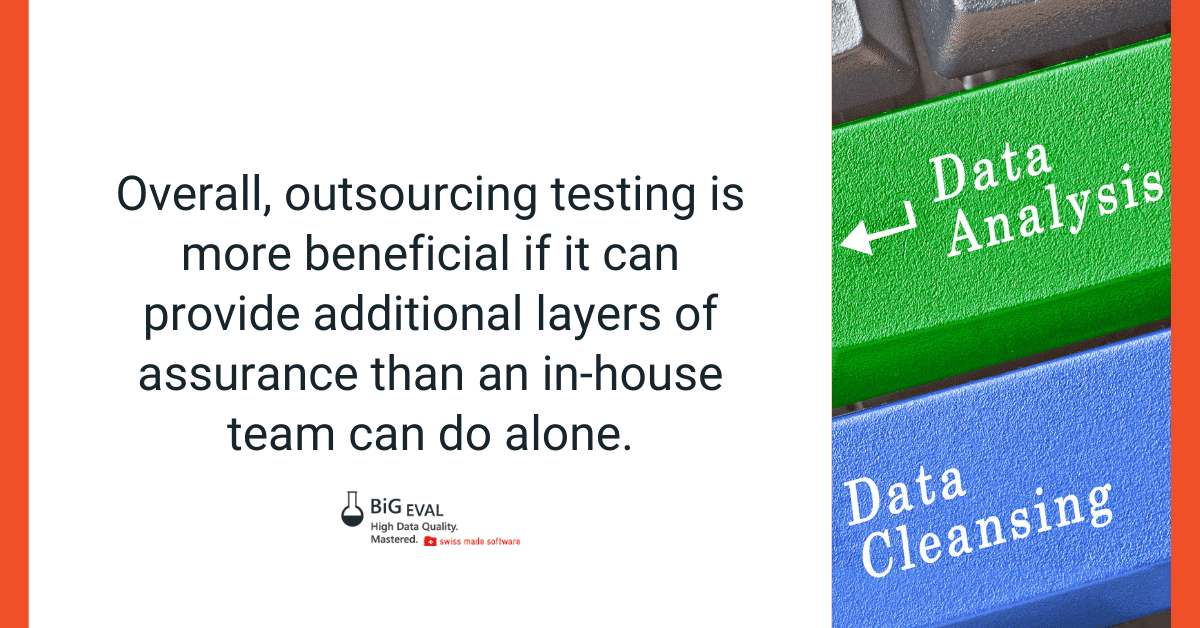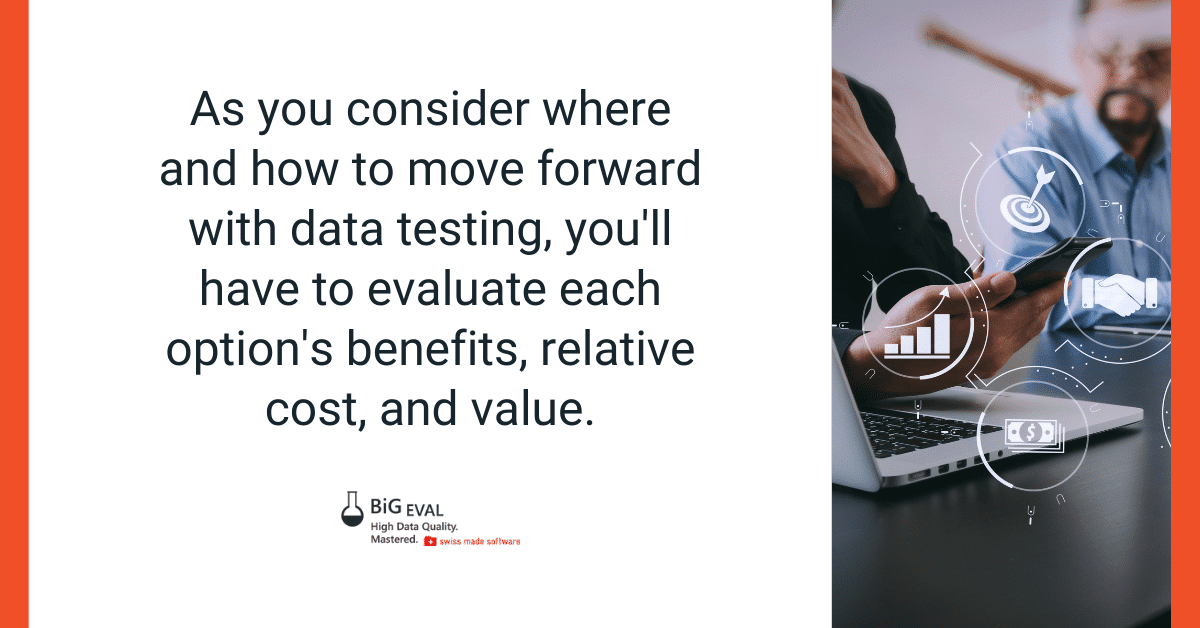A Fresh Look: Do Developers Need Outside Data Testing Automation?
Everyone can agree that data testing is essential to ensure that all the parts of your data-oriented product will work properly throughout its lifetime. But is it better to outsource data testing or keep it in-house?
Everyone can agree that data testing is essential to ensure that all the parts of your product will work properly throughout its lifetime and your end-users will be satisfied.
As a software provider, we know this very well — companies, teams, and individuals use BiG EVAL's data testing automation software to ensure the data they're reliant upon is of the highest quality.
Some of our clients use in-house teams to manage data quality, and others choose to work with a partner specializing in data quality assurance. And, of course, many utilize internal and external teams for testing.
So, you can say we've seen all sides of this fence!
While there are many practical reasons to keep data testing in-house, there are also benefits to having another party provide the testing, using a Testing as a Service or TaaS model.
We can say with confidence that the more parties examine a piece of software — including in-house and external developers, QA testers, and AI-powered tools — the more successful the final product is likely to be.
Here are five considerations for when you're choosing whether to keep your data testing in-house or outsource it.
5 Reasons to Outsource Your Data Testing Automation
On the face of it, that may seem like an unnecessary expense. After all, aren't you and your team more than competent to handle your own testing? You probably are — but that doesn't negate the many benefits of outsourcing and automating your data testing.
There are also many reasons to keep data testing in-house that make a lot of sense too. In the end, as long as the data or software undergoes a thorough assessment, you’ll meet your goal to offer a successful experience to your end-users.
1. You Know the Software Better Than Anyone
Nobody knows the software you've created better than you. But is that a good thing when it comes to data testing?
The case for in-house:
Because you care about your work, you're likely going to be more thorough in your testing — it's your work and reputation, after all. You know better than anyone what improvements and changes were made and are uniquely situated to ensure they are working.
You'll test problematic items and confirm they are no longer issues of concern. You'll be motivated to uncover any new problems that might prevent the ultimate usability of your software or data.
It's critically important for projects to be managed, tested, and updated by the teams responsible for them, not only because they care about the project but also because they care about the outcome more than outside providers could. You know your software better — and your stakeholders' needs — better than anyone.
While we aren't able to test your data ourselves, we work with many partner organizations that provide outsourcing services using our tools. , and we will be happy to connect you with a partner.
The case to outsource:
If you care about your work, which we're sure you do, sooner or later, you'll become a bit too involved in your own projects. As a result, you can develop blind spots that may prevent you from seeing the situation clearly.
Chances are you'll end up testing for specific situations you have experienced in the past or issues you believe to be critical. However, you won't test for situations you're unaware of or don't expect.
That's why you need outsider input. Two heads are always better than one. Partnering with an external provider can be one of the most effective and cost-efficient ways to prevent development errors.
2. You Fix Things As You Go
Is it preferable to create a complete system and then do a full system check at the end, or to build, test, and fix in a repeated pattern?
The case for in-house:
Every developer has to make choices under pressure to deliver results. Agility is prized, and rapidly prioritizing what's needed to deliver desired results will improve a system's efficiency. Ideally, you'll be in a regular cycle of building, testing, and then fixing things as you go, starting at an early point in the process.
While this method can compete with dedicated, standalone testing of a whole system, it's best to build rigorous testing into the development process. Automation software can help manage the kind of ongoing, regular testing that ultimately benefits the entire system throughout its lifespan.
While the fixing may be intermittent and focused, your team will know the system design better than an outsider, including the causes and effects of changes. Without that development cycle of build, test, and fix, this holistic view wouldn't be possible.
The case to outsource:
Developers are under a lot of pressure to deliver results on a rolling basis. When tests succeed, most proceed with their work. When tests fail, they immediately fix the issue at hand and move on without diving deeper and carrying out a full-system check. What's more, tests aren't usually repeated to ensure that the problem doesn't arise again.
The problem with this approach is that there are many reasons a system component may break or stop working properly when you add new features or change existing ones. Often, there is no apparent direct connection between these features. Without a full-system check, such glitches can be easy to miss (until they negatively affect an end-user.)
Outside data testing automation can help with that. Instead of testing individual sections and doing the occasional spot fix, you can do repeatable whole-system and component testing with every release to ensure that everything is working as it should.
3. You Don't Have Enough Time
There's never "enough time," and that won't change, no matter how data testing is managed.
The case for in-house:
Scrambling to find an appropriate testing solution can take as much time (or more) as implementing a solution yourself. It can be challenging to find a trustworthy, qualified partner, create the scope of work, and provide the specifications for a service quote.
Additionally, good communication takes time. When you're already in a time crunch, collaborating and managing communication workflows with a third party can be challenging. The additional meetings, organization, tracking, feedback, and quality monitoring can quickly strain already limited resources.
If time constraints are an ongoing issue, it may be better in the long-term to expand the development team's capacity with additional internal staff rather than ramping up an outside firm.
When you're doing software quality testing in-house, you'll be able to communicate with stakeholders and other teams more quickly and have more control over the entire process.
The case to outsource:
When done right, testing is a time-consuming and painstaking endeavor. In addition to writing the code itself, you also have to develop testing strategies, write project documentation, coordinate with various stakeholders, carry out data validation testing — and all that comes before the unit testing.
You have a finite amount of time and resources, so doing all that work yourself just isn't realistic. And even if it were, the quality of the final product would likely be questionable. You should keep coding and testing as two separate roles for best results.
An additional benefit to outsourcing is that it leverages the power of an entirely new team, providing a large pool of professionals. If properly planned and with a well-considered communications workflow, it could be much more efficient. And, if teams are in vastly different time zones, work can happen almost like magic overnight, which would be unlikely to occur with in-house resources.
4. You Need to Do More Acceptance Testing
Acceptance testing is the final step before a development project can be completed. Nobody wants to have the end-user discover a flaw in the system or discover that data isn't correct at a critical moment.
The case for in-house:
In-house teams understand the needs of the end-user very well. After all, they literally built something for those users! A deep understanding of the requirements and business processes gives in-house testing an edge.
Ideally, a team has been conducting tests throughout the development process, leading to smoother rounds of acceptance testing.
To increase efficiency, planning for acceptance testing can start as soon as the program specifications are finished.
Even if an organization chooses to have external acceptance testing, they can leverage an unrelated internal team for alpha testing. In cases where an internal team will be using the data, it makes even more sense that they are both the alpha and beta testers.
The case to outsource:
Acceptance tests are a critical part of every development project. However, they are usually done only once before releasing a new feature. This can be a problem, as system components could break suddenly for various reasons at any point during the process.
For this reason, acceptance tests should be repeated with every release. Unfortunately, this requires a huge effort by the multiple actors involved in acceptance tests, making frequent testing unrealistic for most organizations relying solely on internal teams.
An external data testing provider can take that load off your shoulders to ensure effective, reliable, and consistent acceptance testing. Often, outsourcing offers greater scalability overall by freeing developers from test execution, allowing them to accelerate other tasks, including incremental testing of their other projects.
5. Nobody's Methods Are Perfect
No matter how good you and your team may be, it's always advisable to recognize the potential for error and conduct repeatable and robust testing as a matter of standard protocol.
The case for in-house:
If you can take an objective approach to your solution, you can recognize that your methods aren't perfect and constantly learn from them. Plus, if you've been regularly integrating testing into your development process, you'll be able to recognize what perfection would look like and what it would take to attain it. You'll have lots of specific, first-hand experience to help you plan and conduct testing.
An outside team may have a different approach and perspective, including a rigid process, whereas an in-house team will have more flexibility. An external team's work will need to be validated and checked for quality as it would with an in-house project. Keeping testing internal also allows you to choose the best software for your process. A third party may have strong preferences for specific tools, and you may have little input in the matter.
An internal team with a grounded, realistic perspective will lean on each other and accept feedback (and the results of testing efforts.) If your goals are clear and achievable, software tools can help make internal testing more manageable, efficient, and reliable.
The case to outsource:
If you've been in the industry for a long time, it can be tempting (and easy) to assume that you know all there is to know about this line of work and that the solutions you build yourself will be flawless. Many developers fall into this trap and end up doing insufficient testing.
Outsourced work can provide a more comprehensive array of talent and experience than your internal team may have. The approach consensus of an experienced team should result in a high ROI.
Repeated testing is the only way to ensure that all components will perform adequately during the product's entire lifetime. Otherwise, you risk things breaking suddenly with each following release.
It can be hard to hear a critique from a teammate. Additionally, test results and objective feedback from an outside party can reduce the potential for bruised egos and minimize internal conflict.

Testing Lends Confidence, No Matter Who Conducts It
As you consider where and how to move forward with data testing, you'll have to consider each option's benefits, relative cost, and value.
Overall, outsourcing testing is more beneficial if it can provide additional layers of assurance than an in-house team can do alone.
However, most businesses find that the collaboration between an in-house development team and using a TaaS team for quality assurance creates the most successful scenario. When these teams are brought together, their combined experience, skill, and understanding of requirements and data produce a more robust result.
And, given the benefits of testing during all development phases, adopting data testing automation software can help internal teams be more prepared to fully realize the advantages of an outside team when it's time. And, of course, testing at every stage will improve the quality and success of your end-user experience.
BiG EVAL provides testing automation software that can help your organization save precious time, money, and resources with our data testing and quality management platform.
Reach out to us with your questionsFREE eBook

Successfully Implementing
Data Quality Improvements
This free eBook unveils one of the most important secrets of successful data quality improvement projects.

